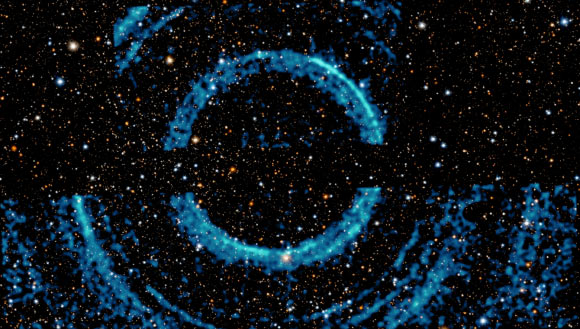
Astronomers Spot Giant X-Ray Rings around Stellar-Mass Black Hole
Astronomers using NASA’s Chandra X-ray Observatory and Neil Gehrels Swift Observatory have detected a set of eight X-ray rings around a low-mass black hole in V404 Cygni, a binary system located about 7,800 light-years away in the constellation of Cygnus. These rings are created by light echoes, a phenomenon similar to echoes on Earth from sound waves bouncing off hard surfaces.
V404 Cygni is a so-called X-ray binary comprising a stellar-mass black hole and a star orbiting one another.
In this type of binary system, material flows from the star towards the black hole and gathers in a disk, where it is heated up, shining brightly at optical, UV and X-ray wavelengths before spiraling into the black hole.
V404 Cygni first jumped to prominence during a nova explosion more than 70 years ago, in 1938.
The system also produced eruption in 1989, which was discovered by the Japanese X-ray satellite Ginga and high-energy instruments on board the Mir space station.
On June 5, 2015, NASA’s Neil Gehrels Swift Observatory discovered a burst of X-rays from V404 Cygni.
The burst created the high-energy rings from a phenomenon known as light echoes.
Instead of sound waves bouncing off a canyon wall, the light echoes around V404 Cygni were produced when a burst of X-rays from the black hole system bounced off of dust clouds between V404 Cygni and Earth.
In their research, University of Wisconsin- Madison astronomer Sebastian Heinz and colleagues analyzed 50 Swift observations of V404 Cygni made in 2015 between June 30 and August 25, and Chandra observations made on July 11 and 25, 2015.
They identified eight separate rings in the 2015 X-ray echoes of the system.
“These rings tell astronomers not only about the black holes behavior, but also about the landscape between V404 Cygni and Earth,” they said.
“For example, the diameter of the rings in X-rays reveals the distances to the intervening dust clouds the light ricocheted off.”
“If the cloud is closer to Earth, the ring appears to be larger, and vice versa.”
“The light echoes appear as narrow rings rather than wide rings or haloes because the X-ray burst lasted only a relatively short period of time.”
The astronomers also used the rings to probe the properties of the dust clouds themselves.
“We compared the X-ray spectra to computer models of dust with different compositions,” they said.
“Different compositions of dust will result in different amounts of the lower energy X-rays being absorbed and prevented from being detected with Chandra.”
“This is a similar principle to how different parts of our body or our luggage absorb different amounts of X-rays, giving information about their structure and composition.”
“We determined that the dust most likely contains mixtures of graphite and silicate grains.”
“In addition, by analyzing the inner rings with Chandra, we found that the densities of the dust clouds are not uniform in all directions. Previous studies have assumed that they did not.”
